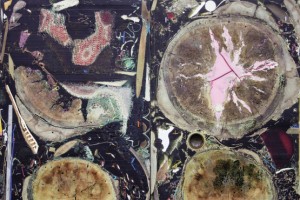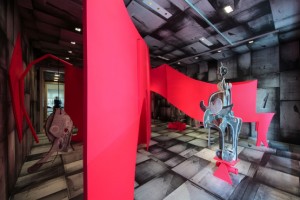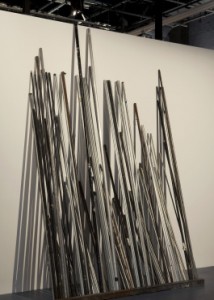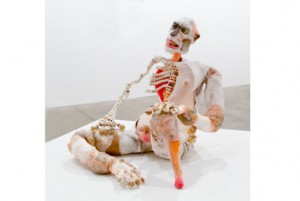If you enjoyed my recent post featuring Brazilian artist Maria Nepomuceno’s vibrant abstract sculpture, see more of this gorgeous exhibition in the video below. With her repeated curving, organic forms, Nepomuceno aims to represent movement into our own inner depths as well as an expansion into the infinite.
Category: Reviews
Review articles written by Merrily Kerr
Jedediah Caesar at D’Amelio Gallery

As he did for his 2010 show, Jedediah Caesar pairs gorgeously hued cast-resin sculptures with drabber offerings in his latest outing, necessitating an unfortunate choice for viewers: Fall back on enjoying the now-familiar resin pieces, or try to engage the work that’s not as compelling.
Caesar creates the former by embedding found objects (in this case, rocks collected in the Mojave Desert) into blocks of variously colored resins, before slicing the forms like a loaf of bread to reveal whatever formal arrangements chance created. The latter are represented here by three bulky, sand-castle-like sculptures made of clay, stamped with the imprint of various hard-to-identify items sourced in New York. The impressions left behind include wedge shapes, dots and dents suggesting a little pig sticking its nose where it didn’t belong. Unlike the resin pieces, which have an insect-trapped-in-amber allure, the clay works seem inert, presenting a sense of disconnection in lieu of a poetic evocation of absence.
For some of his previous resin pieces, Caesar sawed off thin tiles to form stacks, or grids on the walls. Here the highlight consists of similar rectangles assembling into a baseboard around the gallery, proceeding in the order in which they were originally cut. This affords an opportunity to see how various patterns unfold and surprising associations arise. Klimt’s jewellike decorations come to mind, but at heart, Caesar’s process is about making the mundane seem extraordinary—or at least aesthetically pleasing.
Aaron Curry, ‘Buzz Kill’ at Michael Werner

When asked how he felt about his imitators in a 1962 interview, Alexander Calder replied, “They nauseate me.” Aaron Curry’s recent sculptures—which continue to blatantly quote the biomorphic forms pioneered by Calder, Frederick Kiesler and other High Modernists—suggest he wouldn’t mind irking his art-historical predecessors. The show’s tongue-in-cheek centerpiece, Buzz Kill (a hot-red rendition of a Calder-like stabile in aluminum), as well as other sculptures featuring curvy interlocking shapes à la Kiesler and Noguchi, seems eager to take down modernism’s utopian ideals without offering much in their place.
The space-hogging Buzz Kill—along with a grainy black-and-white wallpaper of Minimalist collage patterns that plasters the space, floor and ceiling included—hints at a major statement by aggressively altering the gallery’s townhouse setting. But the work fails to go beyond a kill-the-father treatment of modern art. A recurring image within the wallpaper resembles a straight razor at first glance, and a disembodied cardboard “head” briefly conjures dread, before the limp phallic protrusion it dangles from disperses any serious reaction.
The pieces in the foyer (small paper collages featuring a sci-fi sex-goddess type atop a primitive sculpture, and an alien head affixed to a nude female totem) prime viewers for a transgressive punch that the exhibition fails to deliver. Instead, we get more of the artist’s now-signature wooden sculptures composed of organic, interlocking shapes, including Dezvil, which doesn’t resemble an evil presence so much as a goofy moose with someone clinging to its back. The modernist hope of creating a harmonious society through art may be dead, but stasis and pastiche aren’t suitable replacements.
Virginia Overton at The Kitchen

Virginia Overton’s habit of using unexpected objects to challenge our experiences of a particular space would seem well suited to the Kitchen. Yet the five sculptures she presents in this exhibit—made from steel pipes, two-by-fours, pedestals and other items collected behind the scenes at this venerable nonprofit—don’t greatly alter our sense of the institution, though they do reflect on the relevance of Minimalism today.
In the past, Overton’s sculptures have sometimes involved startling incongruences, but the pieces here—like a collection of well-used rigging poles propped against the wall and lit to create an elegant installation—look more attractive than out of place. Others carry on a more overt conversation with 1960s Minimalist art, such as the strongly spotlit, diagonally wall-mounted steel bar that recalls a Flavin fluorescent tube, or the floor-bound array of creaky two-by-fours that noisily raise one’s awareness of his or her footsteps, à la Carl Andre.
These two pieces and others touch on Minimalism’s penchant for interacting with or altering the exhibition space, but Overton ostensibly wants to elicit a deeper understanding of the venue’s identity (in this case, as a gallery and a theater). By quoting Minimalist aesthetics, she brings to mind concerns with light, space and viewer participation, all topics clearly relevant to the Kitchen’s history as a performance center. Considering the highly experimental nature of that history, however, Overton could have taken more risks, instead of just settling for tasteful arrangements.
Monica Cook, ‘Volley’ at Postmasters

Figurative sculpture of fantastical creatures being rare in Chelsea, Monica Cook’s first New York solo show starts out as strange, but gets more eccentrically alluring. A monkey-like character by the door sets the tone with a dignified look in his eye but a half-finished, diseased-looking body. His simian brethren, in sculptures, photos and a stop-animation video, are equally grotesque, cobbled together assortments of fur and plastic. They recall David Altmejd’s gaudy giants, but elicit more sympathy.
A parent-and-child grouping and a female with her dog hint at the possibility that the beasts are stand-ins for us humans. This suggestion is confirmed by the video, in which the critters court and mate in a manner recalling Cook’s excellent 2010 YouTube Play contribution (not in the show), featuring romantic encounters driven by bestial desires. Things work out better in Cook’s animal kingdom, however, as ulterior motives fall by the wayside and, after a series of shy glances, a male magically impregnates a female by merely proffering her a bauble.
The fact that this pretty seed was torn from a fetus-like pod, or that the female attracts the male by munching on an olive-like oval pulled from the skin of her leg, is the repulsive flip side to these creatures’ damaged beauty. Missing flesh reveals skeletons cleverly constructed from coiled phone cords, internal organs made of glass balls and baboon bottoms filigreed with lingerie-like ornamentation. Despite their disconcerting appearance, their rituals of attraction and reproduction are sincere and absurdly simple, offering a kind of prelapsarian seduction of their own.